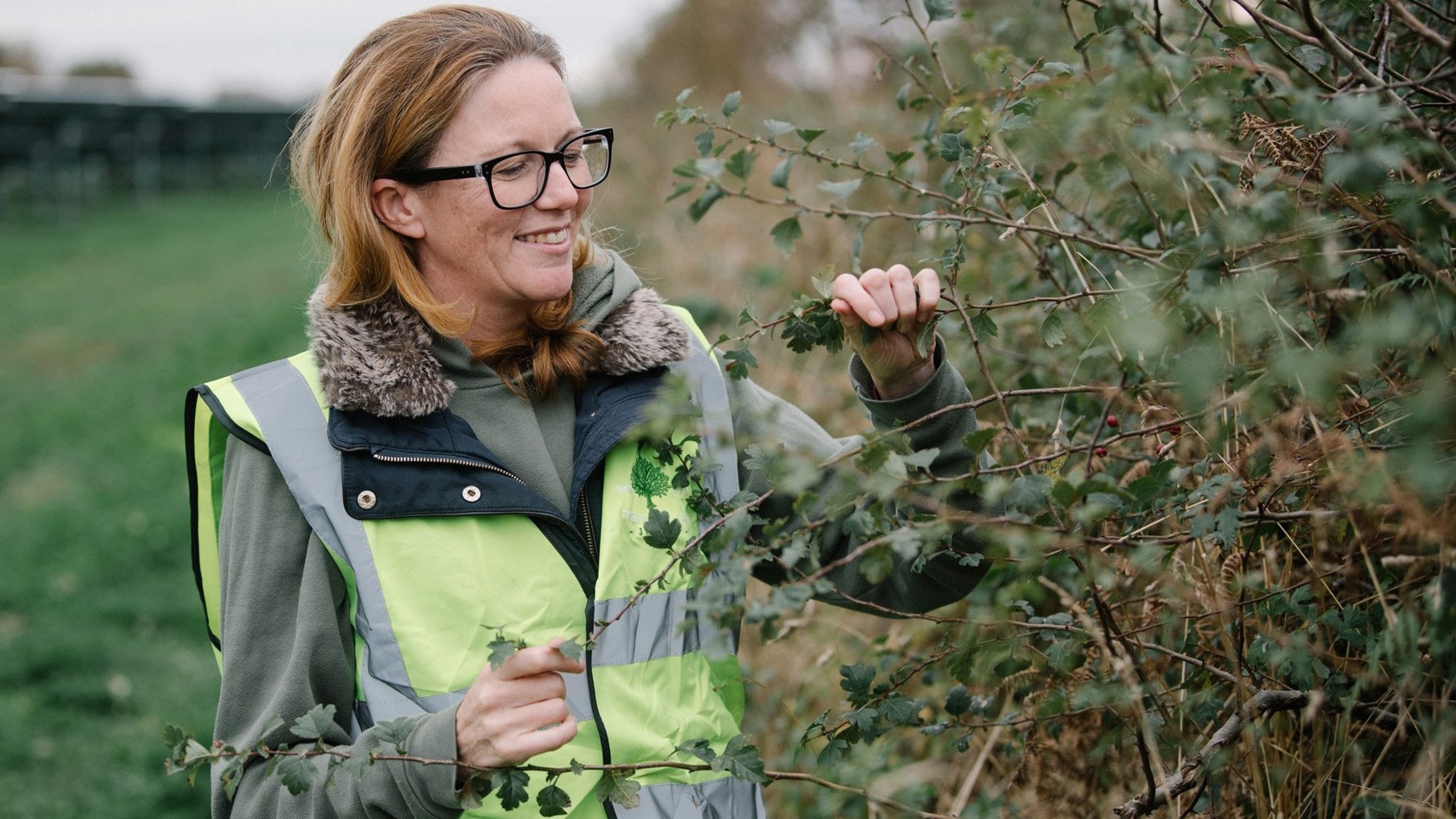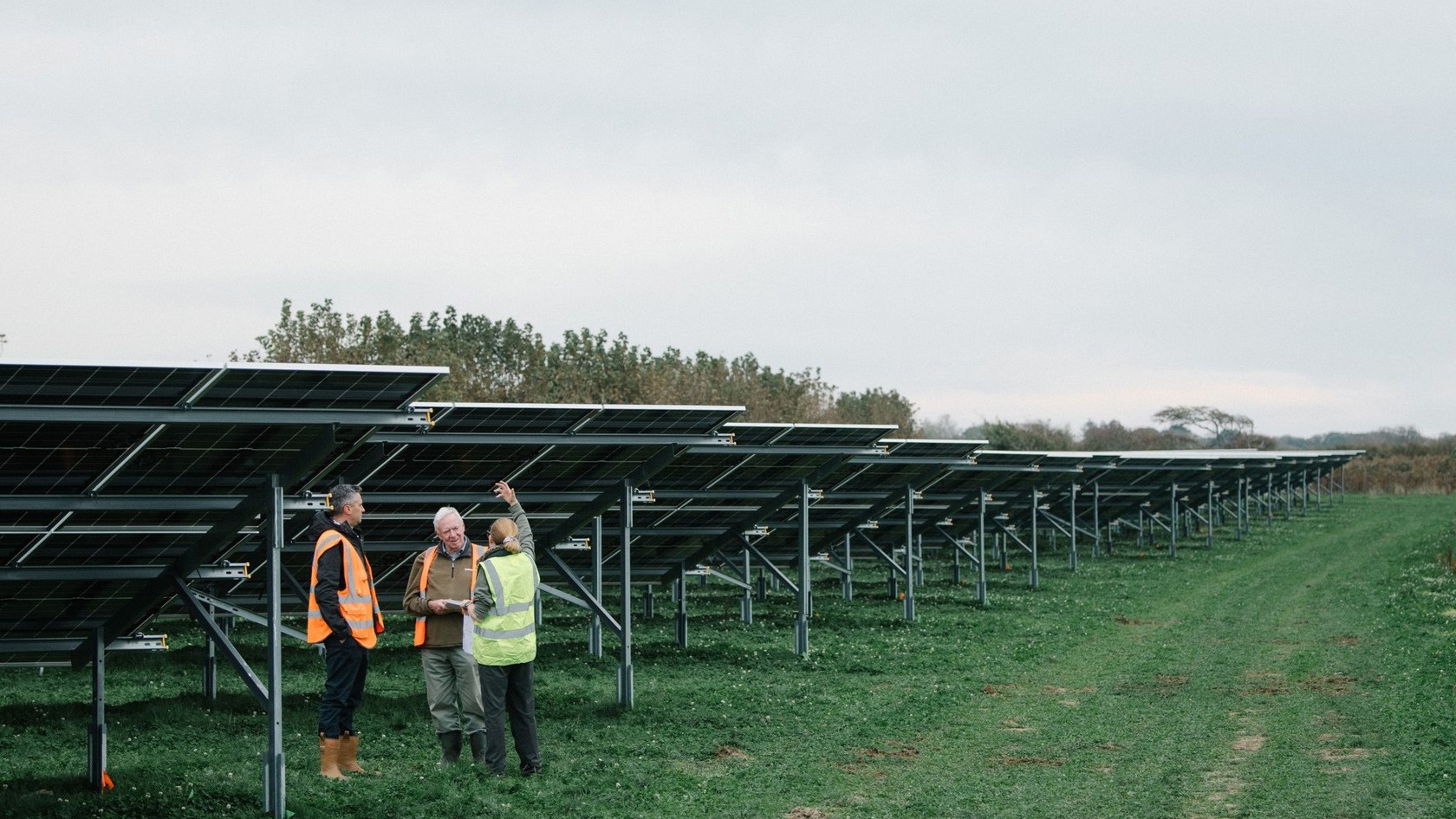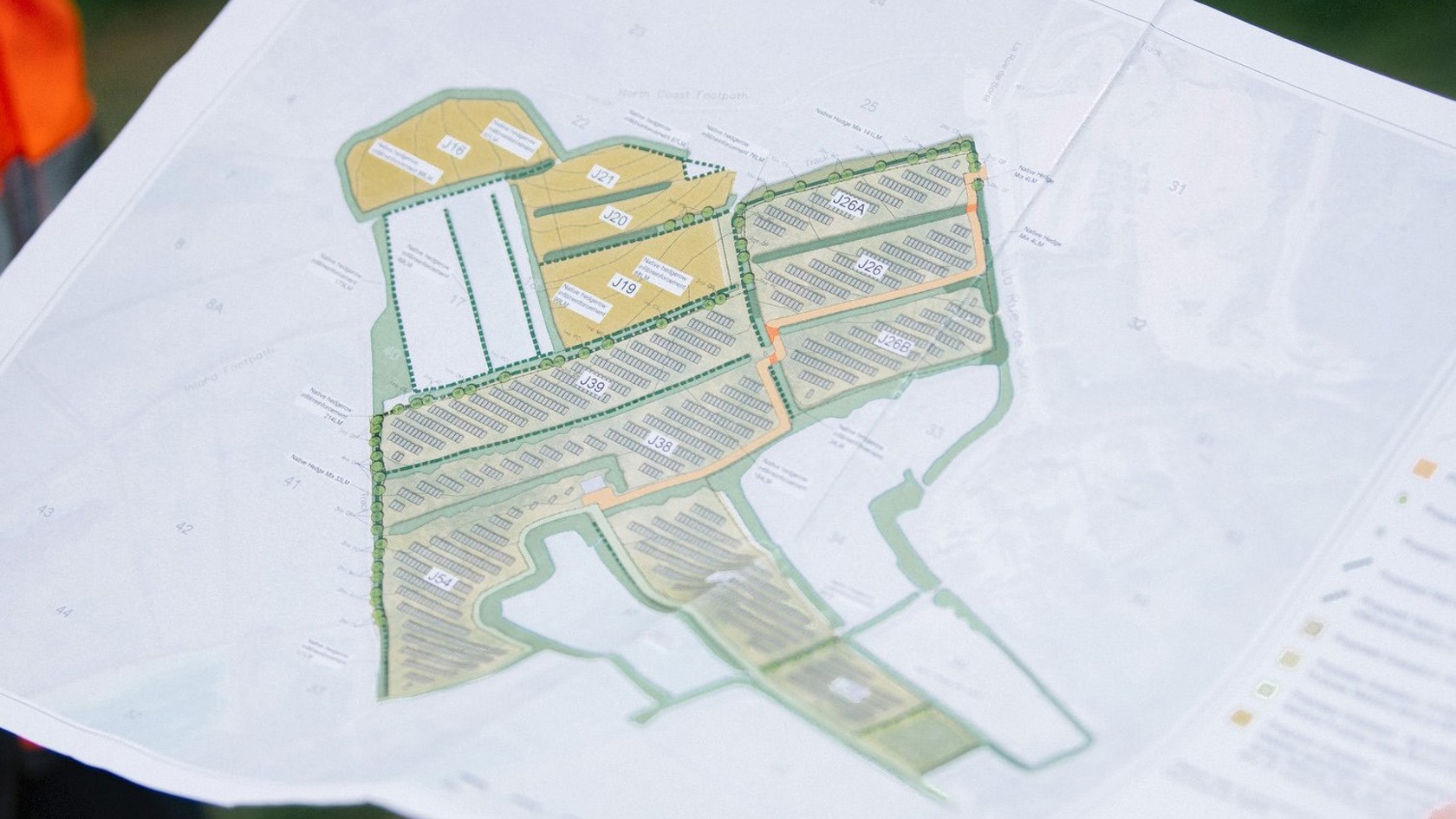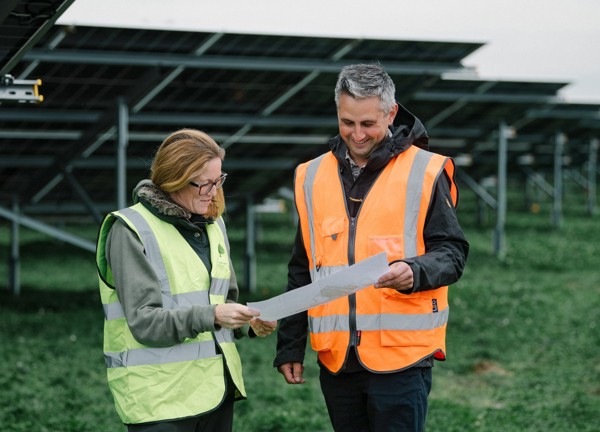This article first appeared in the Jersey Evening Post on Monday 6 October 2025.
Go to the car park at Sorel Point, or to the adjacent footpath and nearby fields, and you will hear the sounds of work in progress on a construction site, and see lorries and machinery trundling along a new pathway leading into the midst of a solar farm.
The solar panels are in place, but there is still work in progress. On completion, 5,920 solar panels will produce 3.6 megawatts of electricity – enough to power 540 full electric Jersey homes, or the equivalent of 41% of properties in St John.
The statistics come from the solar power project manager at Jersey Electricity, James King, who, together with the chief executive of Jersey Trees for Life, Alex Morel, were both kindly showing me round the new solar farm site.
But the noise and disruption of a construction site will only be short term, James said, and the installation itself will be fully screened from public view by trees and hedgerows. And in cooperation with JE, Jersey Trees for Life will be embarking on another mammoth tree planting project this winter.
“Planting a hedgerow is a wonderful way of promoting biodiversity,” Alex said. “Hedgerows are where pollinators all live; they provide shelter for animals; it reduces by tenfold the wind velocity affecting crops. It reduces soil erosion as it is disturbed less – so these are all great things for the quality of the soil, for carbon capture, and, in general, for agriculture.”
For anyone who knows the area, “wind velocity” is a notable feature… or in other words, it’s usually sensible to wear a coat if you are going for a walk thereabouts.
The seven rather tired potato fields now being transformed into a solar farm – very often exposed to windy weather – were not among the Island’s most productive fields.
“Planting a hedgerow is a wonderful way of promoting biodiversity. Hedgerows are where pollinators all live; they provide shelter for animals; it reduces by tenfold the wind velocity affecting crops. It reduces soil erosion as it is disturbed less – so these are all great things for the quality of the soil, for carbon capture, and, in general, for agriculture.”
Alex Morel, CEO, Jersey Trees for Life.
James said that in a really exposed location such as Sorel, screening was not merely cosmetic, it was vital. “We go to great lengths to ensure that our system withstands the effects of the weather, and the panels themselves act as a windbreak.
“So, there will be new hedgerows and trees, and plantings to fill in the gaps in existing hedgerows.”
He added that he understood the concerns of Islanders alarmed at an apparent loss of countryside, but the positive results of the transformation would greatly outweigh any negatives. The most central part – the electricity sub-station – would be so well screened that nobody would be able to see it.
The land would not be ploughed up every spring, so ground-dwelling birds could enjoy their habitat undisturbed.
“Our focus is on the health of the soil. Having lots of different grasses and plants will help the soil health to improve.”

In hot summer weather, sheep would find shade under the panels. Their dung would provide invertebrates on which the nearby red-billed choughs could feed.
James said that a management structure was in place to make sure that worming the sheep didn’t take place on-site, as that kills the invertebrates that live in the sheep dung.
“We did a baseline soil sample before we started work, and are continuing to sample to monitor any changes. We think we’re going to see some improvements, because there will be no industrial farming and no pesticides.
“As the sheep trample the soil, it will get aerated; the dung will go down and naturally fertilise the soil.
“Certain things have to be maintained to preserve or enhance the habitat, and to ensure that species are not expelled from the site. This will be a well-protected microhabitat.”
What about bird life? Will we get skylarks nesting among the solar panels?
“The RSPB released a study last February that looked at solar farms, and concluded that they made positive improvements for a wide range of bird species, such as yellowhammers and finches.”
There will also be “a wild orchard” on site. And what, pray, is that?
Alex answered: “The idea is that rather than having a beautifully manicured orchard that you might find on an extensive private property, this is going to be for the community, with lots of trees there for future foraging. The trees will not be entirely native – there will be walnuts, for example – but the trees are ones we think will survive here, and will produce fruit and berries, blackthorn for sloes, apples, hazel, wild pear and lots of wild cherries.
“People always connect with food, don’t they? But not everybody realises where it comes from, so foraging here will educational as well and help draw people into the countryside.”
James added that a wild orchard really fitted into the ethos of what JE was trying to do.
A major contribution to the site will be the winter planting campaign of Jersey Trees for Life. There will be 5,000 trees planted in total, a mixture of whips (looking like twigs, 0.90 metres to 1.20 metres in height) and trees up to three metres tall.
“This is something the whole family can do. Children love it. Hedgerow planting is not just for adults. Everyone is supervised, the youngest we’ve had has been under two years old, and we have had volunteers in their 80s. There is always something, for everyone to do, even if it is just holding the whip.”
Alex Morel, CEO, Jersey Trees for Life.

The trees will punctuate the hedgerows and add an extra level of biodiversity – you get many more species there. And, of course, the trees will screen the panels.
The stock will arrive in the first week of December, and the following week there will be a call for volunteers to help plant during the planting season, December until March.
“I think it will be popular,” said Alex, “because people will be curious and will want to know what’s going on, and it is slightly out of the way – it’s not somewhere where you just drive past.
“It’s going to be a fun activity. Planting trees is really communal; it’s not physically exerting, and you can chat as you plant. We will work for about two hours in the morning with a tea break in the middle, so we are trying to make the planting sessions as convivial as possible.
“There might even be cakes available to go with the tea” – but, she added hurriedly, “maybe not every day.
“There will always be an educational element. We tell people what trees they are, because, for the average person, they do look like twigs. We will explain about the trees and why we, or JE, selected each tree, in terms of the benefit for birds, pollinators in the spring, or their berries. We will tell them about the importance of hedgerows, so that at the end of the session everybody leaves with a little bit more knowledge, as well as feeling proud that the tree they planted will be in place in years to come, and they can tell their future grandchildren that ‘I planted that tree’.
“This is something the whole family can do. Children love it. Hedgerow planting is not just for adults. Everyone is supervised, the youngest we’ve had has been under two years old, and we have had volunteers in their 80s. There is always something, for everyone to do, even if it is just holding the whip.”
How should volunteers register?
“It’s easy – just go on to our website, click on ‘get involved’, volunteer, fill out a form, and they will see all the events we’ve got, because we shall be probably planting every single day of the week and on Saturdays, maybe even Sundays, but that depends on how I’m feeling.
“All they need to do is to bring gloves – and if they have a spade, bring a spade, certainly wear warm clothes, and be sure to bring just a bit of energy. High heels are not advisable.”
Jersey Trees for Life have planted so many trees that one might have an uneasy thought that in a few decades’ time we shall all be creeping around in a forest. But, of course, many of these plantings are hedgerow trees.
Last year they planted 23,000 trees, mainly on the Railway Walk, because the existing trees there were badly impacted by Storm Ciarán.
In hot weather this summer, neighbouring families helped by watering the young saplings and removing bindweed. The planting was a big operation, but a successful one.
Nearby at Rue de la Sergenté, La Moye, they have planted 665 trees to create what Alex called “a beautiful little woodland”: a complete mix of hedgerow trees and standard trees. Cherry trees were already blossoming this spring, and some of the pines have already grown by a metre; the local community is already using and enjoying the wood.
“We want this orchard at Sorel, which we shall be planting with JE, to be as successful as that one. It will be a bit smaller, and a bit different in that it will have this foraging element to it.”
There have been major plantings as well at Les Varines, another woodland at Bellozanne, and, of course, at the Arboretum in St Ouen, which Storm Ciarán badly impacted.
“We only have a team of 12, so we need hundreds of people to help us deliver what we do. That includes the Probation Service, Back to Work, community and corporate volunteers, otherwise we couldn’t get 23,000 trees in the ground.”
Asked when the solar panels would become operational, James said that Sorel, along with the solar farm at Rue d’Olive, St Mary, would come on stream early next year.
Most of the construction process was now complete, with the sub-stations and the transformer houses, still to do. But he stressed that JE did not want the new solar farm to look like an industrial location.

“Everything has been thought about and orchestrated,” he said. “Sheep, choughs, improving the soil – we are reinvigorating Jersey farming.”
And Alex added: “The trees we are planting will improve Jersey, help the community and enhance the environment.
“Without trees, there is no life on earth.”
For more on Jersey Trees for Life, visit their website.
For more on Jersey Electricity and the solar panel project, visit the project page.






